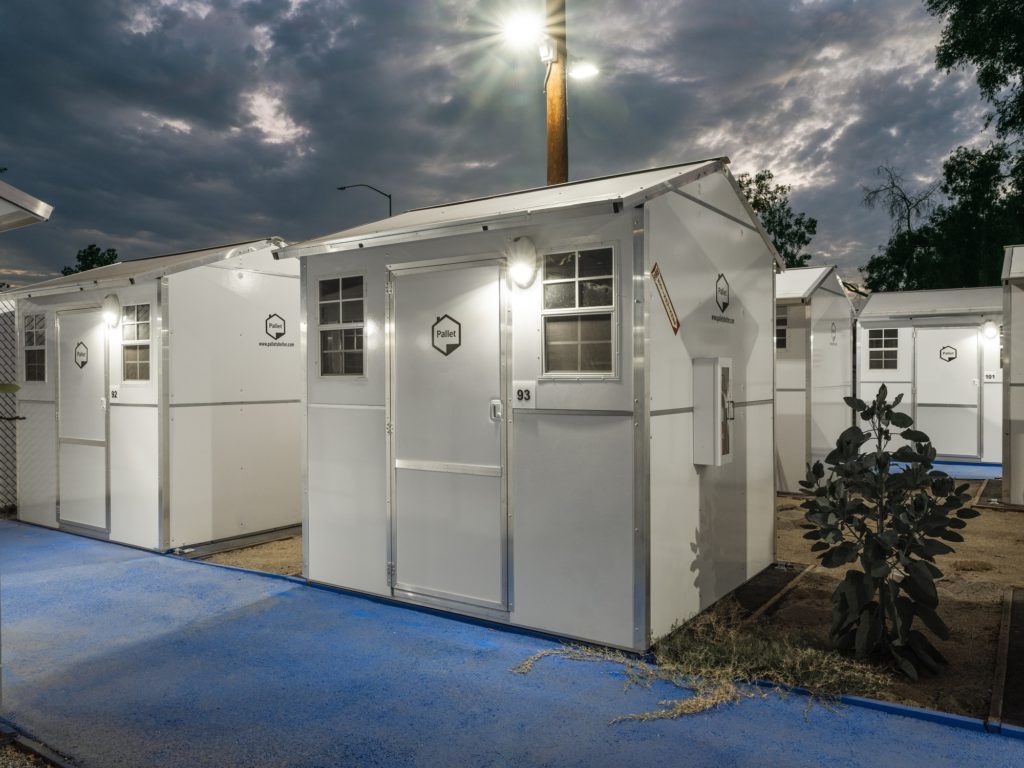Are Pallet shelters safe?
March 26, 2022

Pallet shelter villages are a transitional stepping stone from the streets to permanent housing. The villages provide the dignity and security of private units within a community setting. Residents have access to a resource net of on-site social services managed by a local service provider, appointed by the city or county leading the project. Compared to living unsheltered, Pallet's villages offer respite from the dangers of living outside.
Pallet approaches safety in a few ways. First, our shelters are designed to meet or exceed industry guidelines, and are independently inspected by local authorities prior to residents moving in. Second, we require an on-site service provider as part of our dignity standards, ensuring that residents have the ongoing support and security required for their safety.
Our goal is to create a safe place for residents to rest and recharge as they work on taking the next step. Here's a look at how we've addressed various elements of safety for residents.
Fire Safety
Any structure is susceptible to fire danger. Our team’s construction industry background and knowledge helped in the selection of materials that would be safe for people to reside in, strong enough to weather the elements, and easy to assemble so we can set up villages quickly.
Pallet shelters are made up of a unique material mix that was specifically selected for safety, ease of use, and cost efficiency. The panels meet a Class C fire rating. This classification is a measurement of effectiveness against light fire exposure and is standard practice for all residential and commercial structures. Examples of other Class C building materials include hardboard siding panels, plywood, and masonite. Brick, for example, falls under a Class A rating. There are five classification levels.
The shelter's fire rating meets International Building Code requirements as well as local standards in all of the eleven states we are currently in. Pallet makes fire rating information available before a city moves forward with contracting to build a village. This gives them time to independently verify that the structures meet local code requirements. After assembly, the shelters are inspected to ensure they meet code standards before residents move in.
These measures, paired with the efforts of local authorities, ensure that cities and counties can build Pallet villages with confidence.
"Pallet shelters are designed to prioritize safety, and this is a key reason we chose this shelter intervention," said Oakland City Council President Nikki Fortunato Bas. "They meet code requirements by the State and City departments, including the Oakland Fire Department."
Further, fire safety isn't solely about materials used. Another component includes measures that increase the likelihood of having enough time to safely escape a fire. If a three-bedroom home catches fire, building inspectors have set a standard to protect the resident. Those measures include fire alarms and ample windows and doors that can be used as an exit. Pallet’s shelters make the same considerations, and can be even easier to exit in the event of an emergency given their relatively small size.
In the unlikely event of a fire, all Pallet shelters are equipped with standard fire safety equipment. They include:
- Fire extinguisher
- Secondary emergency egress door
- Hardwired smoke detector
- Hardwired CO monitor
“In designing our shelters, we borrowed fire safety best practices from our background in traditional permanent housing construction,” says Pallet Founder and CEO Amy King. “These practices, paired with independent inspection by local fire authorities, make Pallet a safe solution for cities.”
The units are spaced several feet apart – dictated by local fire code – to minimize the damage if a fire occurs. Shelter spacing also provides more privacy between residents and their neighbors within the village. For additional safety, service provider staff perform regular wellness check-ins on residents. These checks are an opportunity to make sure residents keep the egress door clear and that there are no other fire hazards within the cabins.
Weather Protection
Pallet shelters are also equipped to handle wind, snow, and varying climates across the country. Our engineering team has performed numerous tests to ensure we've produced a quality product where people are protected.
Climate Control
Keeping people comfortable begins with the exterior. The panels of Pallet shelters are white and opaque with a glossy finish. Reflecting sunlight is helpful in the summer. Air conditioning units also help keep the shelters cool. They require less electricity to maintain comfortable interior temperatures due to the reflective nature of the shelter's exterior.
Proper insulation is vital in cold weather and high temperatures. The shelter exterior panels have a foam insulating core. We offer thicker wall and roof insulation, a 4500-watt heater, and insulation under the floor panel as part of a cold-weather package for frigid climates.
Wind/Snow
Tests for windy and snowy conditions show the shelters can withstand 115 mph wind and a 25 lb./sq. ft. snow load for our standard units. Depending on the location, we can also make adjustments to increase the snow load to 50 lb./sq. ft. and wind to 170 mph. An additional safety feature that comes with every shelter includes a proprietary staking system, which allows the unit to be secured to the ground.
Personal Safety
One of the essential safety features of a Pallet shelter is the locking door. When residents are inside their cabin, they can relax and be sure their space can remain private. Staying in a Pallet shelter means they have a set place to focus on the next step. A locking door also means their personal belongings are safe. When someone is experiencing unsheltered homelessness, there's always a risk they'll be asked to move, and it's challenging to hold onto one's possessions.
Other security measures in place at Pallet shelter villages can include fencing, security guards, and full-time staffing from a local service provider.
Safety is a top priority at Pallet. People experiencing homelessness are already in a vulnerable position. We aim to create a safe environment for them to thrive.


